In our experience working with dozens of brands and tracking conversion rates for hundreds of blog posts, we have learned that ranking for bottom of the funnel keywords is the most efficient and effective way to generate conversions through SEO. The inverse — focusing on top of the funnel keywords — is, ironically, the more popular approach to keyword strategy but in our experience it leads to very low conversion rates and ultimately poor ROI from SEO.
In this post, we share data from our client work that demonstrates this, and cover everything you need to know about what bottom of funnel keywords are and what it takes to rank for them.
Table of Contents
- What are bottom of the funnel keywords?
- The main types of bottom of funnel keywords
- Ways to find bottom of the funnel keywords
- How to rank for bottom of the funnel keywords
Note: If you’d like help identifying and ranking for your bottom of funnel keywords, you can learn more about our agency here and reach out about working with us here.
What Are Bottom of the Funnel Keywords?
Bottom of the funnel keywords are search queries in which people indicate that they have intent to buy a product or service. They are also referred to as “buying-intent keywords.”
Top of the Funnel vs. Bottom of the Funnel Keywords
In contrast, top of funnel keywords are keywords that could still be searched by a brand’s target audience, but do not directly indicate that searchers are in the market for their product or service.
In our analyses across dozens of clients, we have found that bottom of the funnel, high buying-intent keywords don’t just convert a little bit better than top of funnel, low buying-intent keywords, they often convert hundreds (and in some cases thousands) of percent better. Yes, it’s that dramatic.
This is summarized in this analytics screenshot from our article on Pain Point SEO (our agency’s foundational SEO strategy):
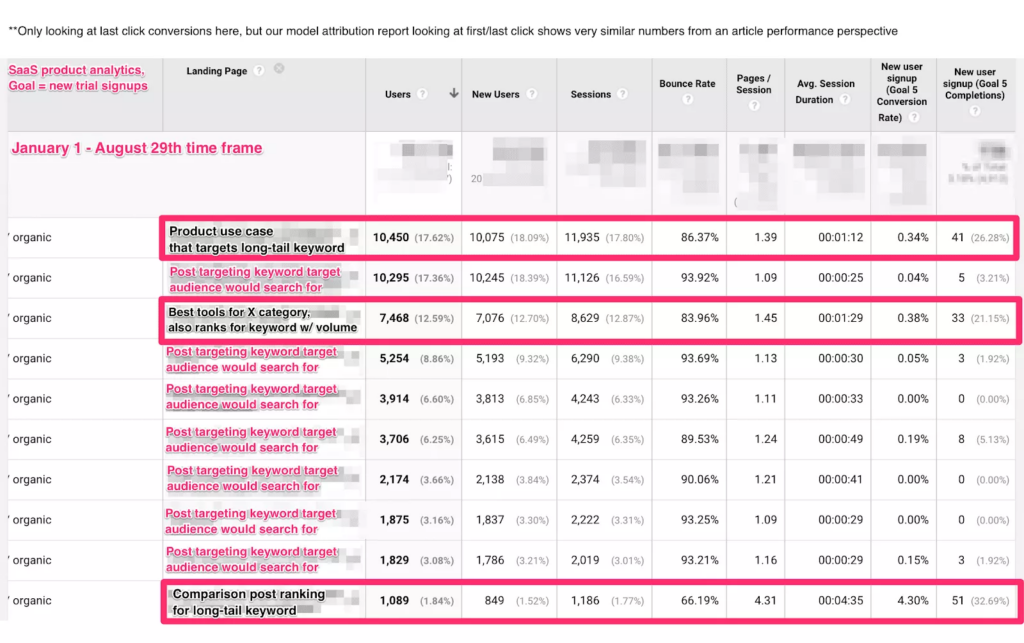
The right most column shows new user signups from each page. The three boxed posts rank for bottom of funnel keywords (via our Pain Point SEO approach). The rest rank for top of funnel keywords, that is, something the target audience could search for, but not a high buying-intent keyword.
The new user signups from the three Pain Point SEO posts are hundreds of percent higher.
We also showed this at a larger scale in an analysis of 60+ posts for our client Geekbot:
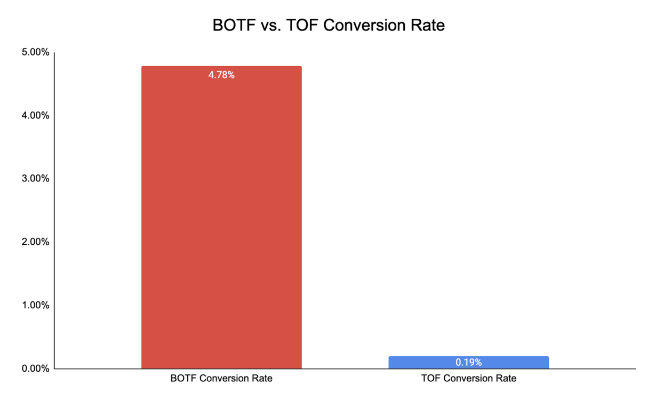
The posts targeting bottom of the funnel, high buying-intent keywords converted 2400% better. In that case study, you can read about how the higher conversion rates more than made up for any differences in search volume or traffic between the two buckets.
This is why we very strongly feel businesses should spend far more effort and time creating bottom of funnel content to rank for their buying-intent keywords before moving up the funnel. But most don’t.
There’s a culture in SEO and content marketing where marketers think their company needs to be the one to educate all potential customers at every stage of the funnel, starting at the top. This is not true, and it results in a huge waste of resources on content marketing that does little to help get conversions. For almost every business, there are plenty of people in later stages of the buyer’s journey that are already searching for bottom of funnel search terms.
Therefore, we think a more effective SEO content strategy should prioritize bottom of the funnel topics to capture people who are ready (or getting close) to make a purchase decision.
The Main Types of Bottom of Funnel Keywords
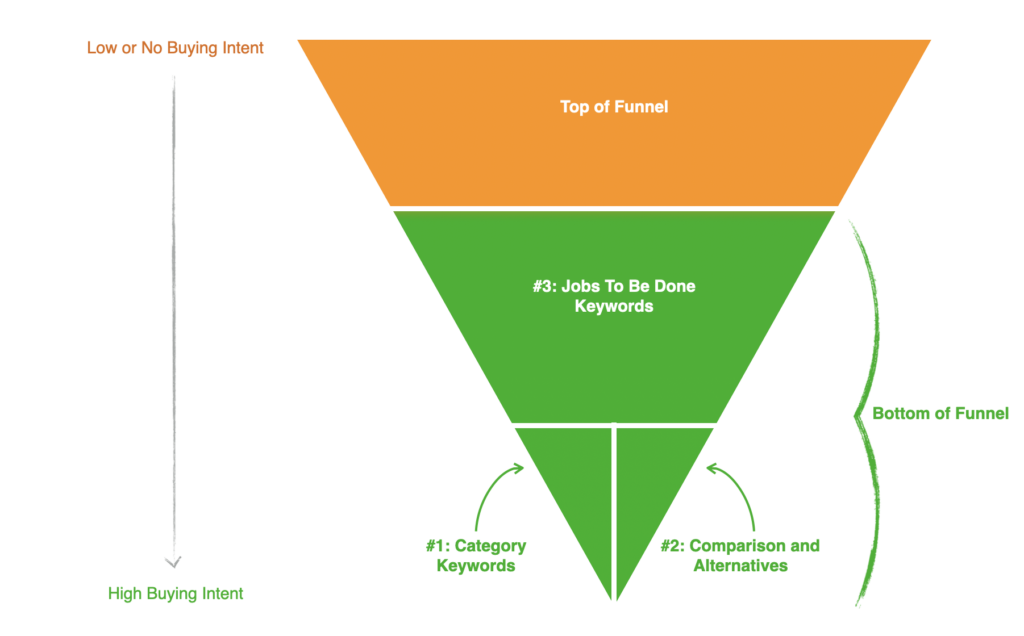
We view bottom of the funnel keywords as any that indicate the searcher has purchase intent (in that respect we don’t care too much about distinguishing between bottom and middle of funnel, anything with buying-intent can be thought of as bottom of funnel). And, as we define in our Pain Point SEO framework, these basically all fall into one of three categories:
- Category Keywords
- Comparison and Alternative Keywords
- Jobs to Be Done Keywords
Let’s define and look at examples of each.
#1. Category Keywords
Category keywords are search queries that describe exactly what you offer — i.e., the person searching is shopping for the specific products or services you offer. They’re the top terms that most businesses are bidding on through Google Ads, and the most obvious keywords that any business would want their website to rank for.
This includes keywords like “best accounting software” or “men’s running shoes.” If you sell accounting software or men’s running shoes, these are keywords you absolutely want to be ranking for. In our case study on What Blog Keywords Convert the Highest?, we found category keywords to have an average conversion rate of 4.85% (to be clear, this is very good — the majority of SEO content that brands publish converts to product related CTAs at less than half a percent). This is why we have long advised that brands prioritize these keywords, and our data presented in that case study further supports that assertion.
A key thing to keep in mind about category keywords is that there are often more category keywords that closely describe your business than many companies realize. For example, if you sell accounting software, you may have distinct category keywords pertaining to different features (e.g. invoicing, time tracking, etc.), industry verticals (e.g. small business, freelancer, etc.), or product category variations (e.g. software, app, tools).
We find that many (if not most) of the clients we work with are in a similar situation where there are many different ways that people search for what they sell. As you begin your keyword research, it’s useful to find as many of these variations as possible.
#2. Comparison and Alternative Keywords
Comparison and alternative keywords are queries that indicate the search intent is to learn about how different solutions compare, and which product or service would best suit their needs.
This includes alternative keywords like “Salesforce alternative” and versus keywords like “Salesforce vs. Pipedrive.” And one of the most interesting takeaways from the case study cited above is that comparison and alternatives keywords convert at a higher rate than any other keyword type. We found them to have an average conversion rate of 8.43%! This is not surprising. Anyone searching these terms knows what they want, even knows the options in this space, and is just comparing before trying or buying one — their buying-intent is very high.
Tactic worth trying: When working with new or smaller brands where there aren’t many searchers looking for their brand versus a competitor, we’ve had success creating content targeting “[competitor] vs. [other competitor]” keywords. We’ll create content for “[competitor] vs. [other competitor] vs. [our client’s brand]” to piggyback off the search volume of people comparing our clients’ competitors, and insert them into the list of options being weighed by prospects. We have found these terms to be relatively easy to rank for, even for clients with low domain authority.
3. Jobs to Be Done Keywords
The final category in our Pain Point SEO framework is “Jobs To Be Done” keywords — queries that describe a job to be done (or pain, challenge) that is best solved with your product or service.
These are slightly more middle of the funnel because they don’t explicitly say “software” or “service” (like category keywords) or mention competitors (like alternatives keywords) — these are mostly “how to” queries: how to organize design files, how to do a poll in Slack, how to get video testimonials from customers.
Although these users may not be aware of your brand, or competitors, or precisely what they need for their problem, they still have the potential to buy because they have a job or problem that you solve.
We insert our clients’ names in these conversations by creating content to specifically solve what the reader is searching for in the context of the client’s solution, and we’ve seen these convert at a ridiculously high rate.
Ways to Find Bottom of the Funnel Keywords
1. Start With Brainstorming Your Category, Comparison, and Jobs to Be Done Keywords
Before you begin using search engines and keyword research tools, it’s worth listing out all of the search queries you can think of in the three bottom of funnel keyword frameworks discussed above:
- Category keywords: List all of the different ways that people might phrase your product or service.
- Comparison keywords: List out all of your top competitors in [Competitor brand vs. Your brand] and [Competitor brand + alternatives] formats.
- Jobs to be done keywords: List out all of the phrases that indicate someone has a problem that your product helps solve. Read our JTBD post for guidance on how to do this.
This brainstorming session will establish a foundation for the rest of your keyword research. You may not end up targeting all of these, but they’ll lead you to discovering your highest buying-intent target keywords.
Note: Check out our post on content ideation for additional guidance on this step.
2. Begin Googling Your BOFU Keyword Ideas
Once you have a running list of bottom of funnel (BOFU) keyword ideas, you can begin analyzing the search engine results page (SERP) for each keyword. This will give you insight into the exact phrasing people are using when they search for that topic, as well as provide you with related searches and other valuable keyword ideas.
As you analyze the SERP for each keyword, here are some aspects to pay attention to.
SEO Titles
The exact phrasing that is used in the search result titles, known as SEO titles (i.e., the blue links), is a good indicator of the specific target keywords and phrasing people are using when they search that term.
In some cases, the SEO titles throughout the page will use the exact phrase you typed in. For example, if you Google “accounting software,” all of the results use that exact phrase in the title. You can therefore feel confident that is the correct phrasing to use as your target keyword.
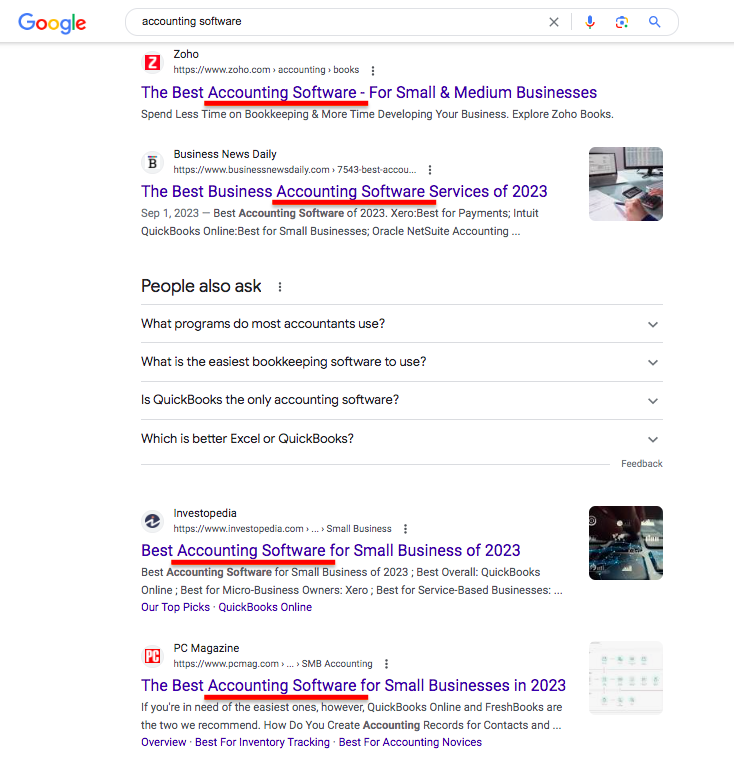
In other cases, you might find that the SEO titles use a different variation of the phrase you typed in. For example, if we look at the SERP for the keyword “executive assistant service,” we see phrases such as “Remote executive assistants,” “Virtual executive assistants,” and “Virtual administrative assistants.”
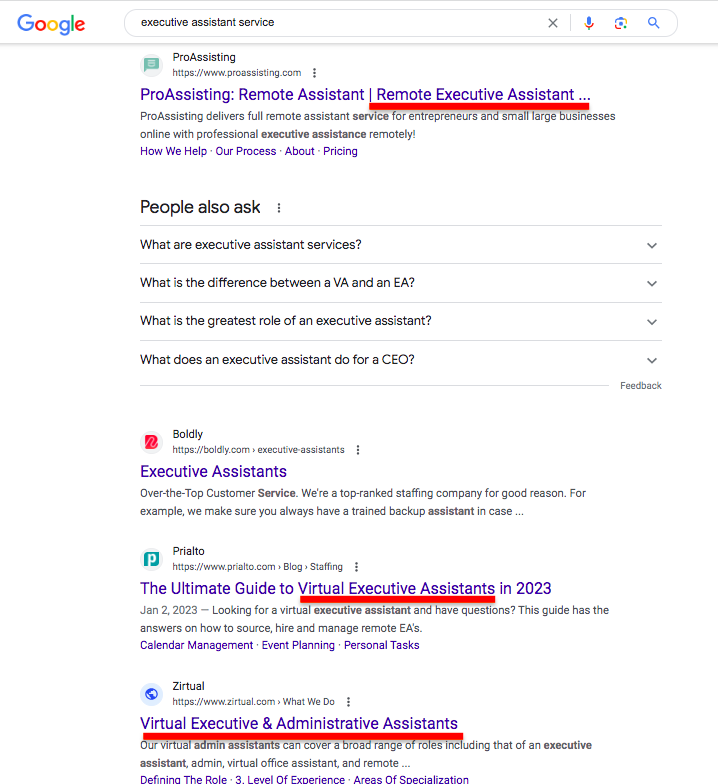
With that in mind, you might decide that a better keyword to target might be (or include) one of those variations.
People Also Ask
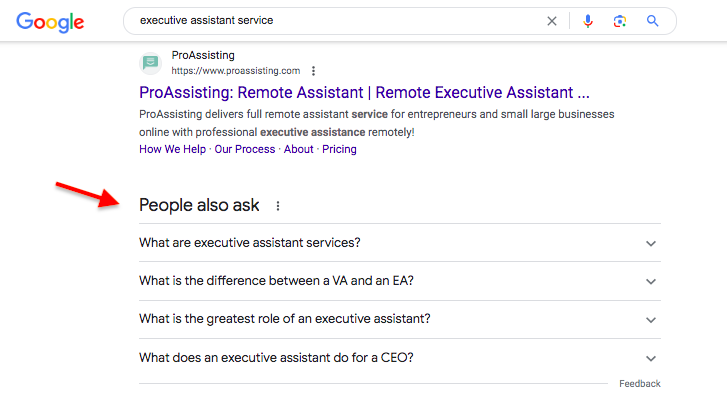
‘People also ask’ is a SERP feature that you can use to figure out subheadings and topics to cover in your page targeting that keyword, as well as find additional keywords that you could target with a dedicated page.
Related Searches
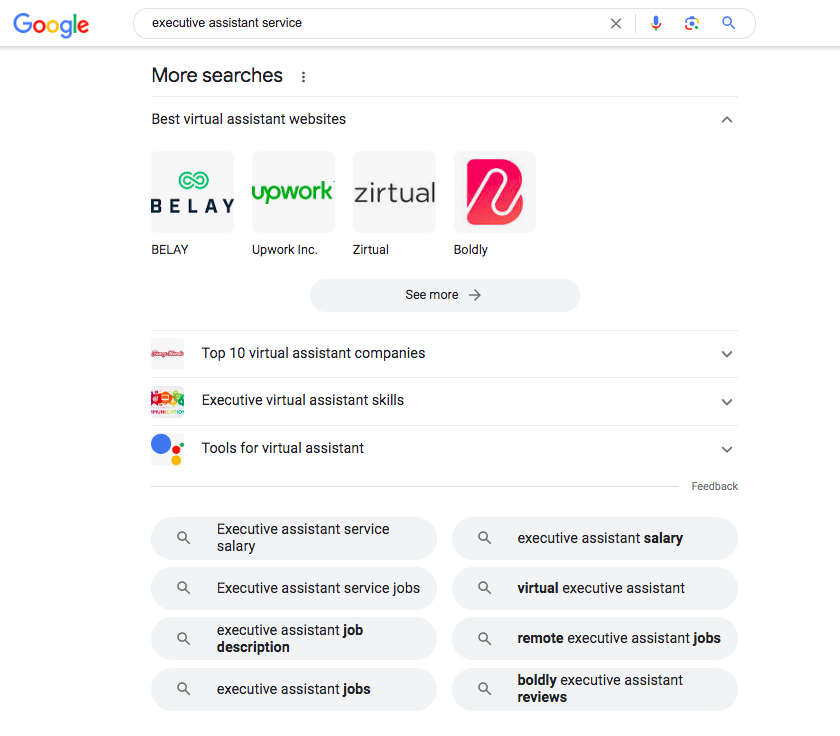
Likewise, the bottom of search engine results pages show related searches that can give you additional keyword ideas to target.
Google Suggested Search
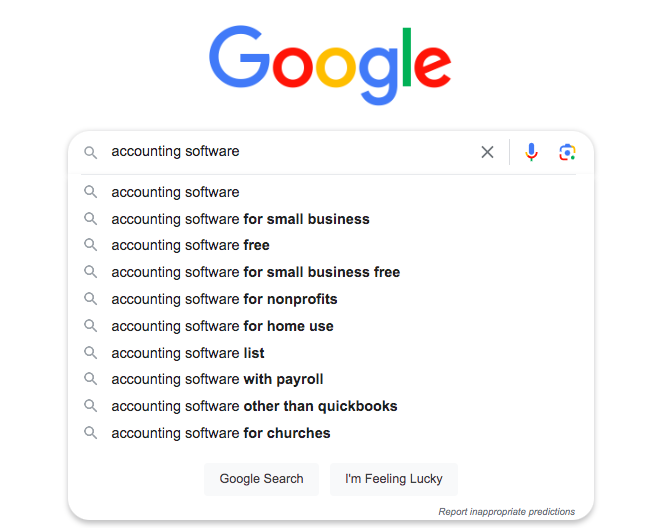
Finally, as you type in your keyword ideas, you can find great opportunities by paying attention to Google Suggested Search. For example, if you type in “accounting software,” you’ll find that people search for “accounting software for small business,” “accounting software for nonprofits,” and “accounting software with payroll.” These could all be potential keywords to target with dedicated pages.
3. Using Keyword Research Tools
By following the two steps above, you can make significant progress on finding bottom of the funnel keyword opportunities to go after. But, once you get this initial brainstorming done, it’s useful to plug them into keyword research tools to:
- See their search volumes
- Find other similar ideas and long-tail keyword variations you didn’t think of
We use Clearscope and Ahrefs, but you can use SEMrush, Google Search Console, Moz Keyword Explorer, or any other keyword research tool.
Here are some examples of how we use keyword research tools to find additional BOFU keyword opportunities:
- Keywords Explorer: Most SEO tools offer a keyword explorer feature that allows you to type in specific queries and find related keywords to that topic. You can use this much like you used Google in the above example: type in the BOFU keywords you brainstormed and find all the similar variations of that keyword. The key advantage of doing this in a keyword research tool, however, is that you get data on search volume and difficulty that can help you be strategic in how you prioritize keywords to go after.
- Content Gap: Tools such as Ahrefs offer a “Content Gap” feature that allows you to review organic keywords for competitor domains compared to your own to see where your keyword gaps are. It’s important to note, however, that most companies are doing a terrible job of ranking for BOFU keywords, so you likely will see tons of top of funnel keywords in your competitors’ rankings. Don’t be scared or deterred from your BOFU strategy when you see this. We assure you, we have seen under the hood of so many brands’ analytics — they are not getting many conversions from these top of funnel rankings. So, it can be useful to filter for specific keyword modifiers, such as “software” or “service,” to find keywords in the various BOFU frameworks discussed above. Check out our post on researching competitor keywords for a deep dive on how to use this tool.
- Organic Keywords: As you publish content to rank for your BOFU keywords, you can periodically plug that URL into your keyword research tool to see all the organic keywords it’s ranking for. Often you’ll find variations of your target keyword in which you’re ranking on some page below page one that also have high buying-intent, but that you could target with a separate, dedicated page to get a top ranking position for that variation of the query.
How to Rank for Bottom of the Funnel Keywords
Understanding the various bottom of funnel keyword frameworks and how to find them for your business is necessary, but the difficult part is creating blog posts or landing pages that actually rank for these buying-intent keywords.
We have written extensively about the in-depth process we use, and that we feel is needed, in order to create content that ranks for these highly competitive BOFU keywords.
To understand what it takes, check out our post on SEO content writing, which covers the following 5 step process:
1. Topic: Come up with content ideas and identify target keywords that have business value.
2. SERP Analysis: Analyze the search engine results page for each of those keywords to understand which topics need to be covered in your article for it to rank.
3. Structure: Choose the angle and structure of your article based on that SERP analysis.
4. Writing: Write the content in a way that fills in that structure with compelling information to sell your product or service.
5. On-Page SEO: Optimize your content with on-page SEO.
We see content marketers make mistakes at every stage of this process. So, as we cover each step throughout that post, we discuss those and their implications so you can avoid them in your business.
Learn More About Our SEO and Content Marketing Agency
- Our Agency: If you want to hire us to execute a content marketing strategy built around driving lead generation and sales, not just traffic, you can learn more about our service and pricing here. We also offer a paid search service which you can learn about here.
- Join Our Content Marketing Team: If you’re a content marketer or writer and would love to do content marketing in this way, we’d love to have you apply to join our team.
- Our Content Marketing Course: Individuals looking to learn our agency’s content strategy and become better marketers, consultants, or business owners can join our private course and community, taught via case studies, and presented in both written and video content formats. We include several details and examples not found on this blog. Our course is also built into a community, so people ask questions, start discussions, and share their work in the lesson pages themselves, and we, along with other members, give feedback. Learn more here.








